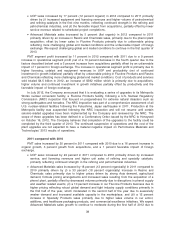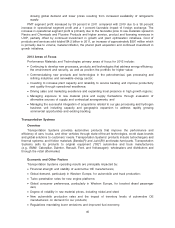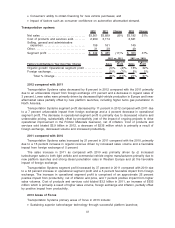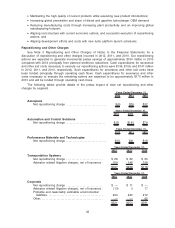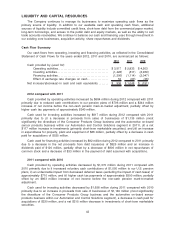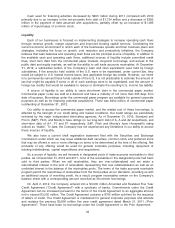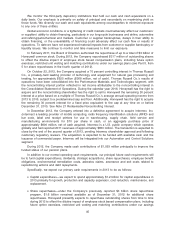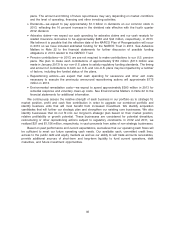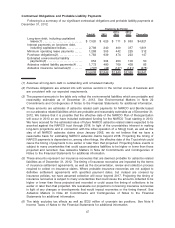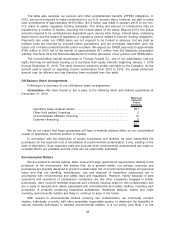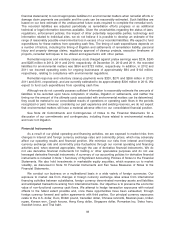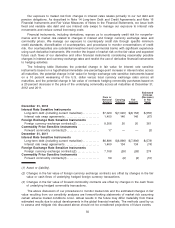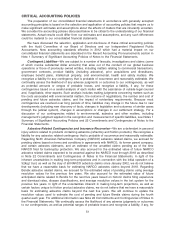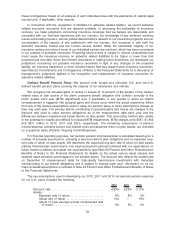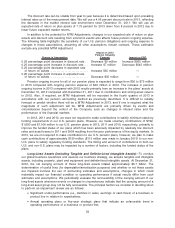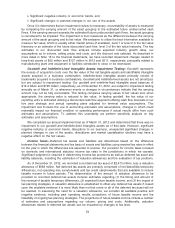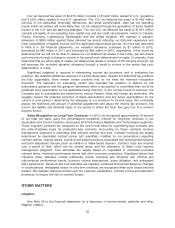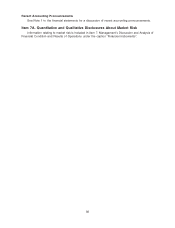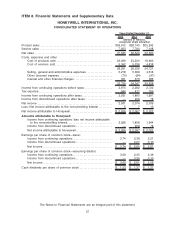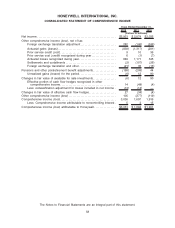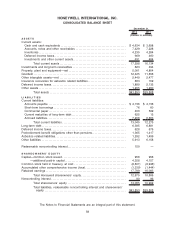Honeywell 2012 Annual Report Download - page 58
Download and view the complete annual report
Please find page 58 of the 2012 Honeywell annual report below. You can navigate through the pages in the report by either clicking on the pages listed below, or by using the keyword search tool below to find specific information within the annual report.financial statements) to record appropriate liabilities for environmental matters when remedial efforts or
damage claim payments are probable and the costs can be reasonably estimated. Such liabilities are
based on our best estimate of the undiscounted future costs required to complete the remedial work.
The recorded liabilities are adjusted periodically as remediation efforts progress or as additional
technical or legal information becomes available. Given the uncertainties regarding the status of laws,
regulations, enforcement policies, the impact of other potentially responsible parties, technology and
information related to individual sites, we do not believe it is possible to develop an estimate of the
range of reasonably possible environmental loss in excess of our recorded liabilities. We expect to fund
expenditures for these matters from operating cash flow. The timing of cash expenditures depends on
a number of factors, including the timing of litigation and settlements of remediation liability, personal
injury and property damage claims, regulatory approval of cleanup projects, execution timeframe of
projects, remedial techniques to be utilized and agreements with other parties.
Remedial response and voluntary cleanup costs charged against pretax earnings were $234, $240
and $225 million in 2012, 2011 and 2010, respectively. At December 31, 2012 and 2011, the recorded
liabilities for environmental matters was $654 and $723 million, respectively. In addition, in 2012 and
2011 we incurred operating costs for ongoing businesses of approximately $84 and $102 million,
respectively, relating to compliance with environmental regulations.
Remedial response and voluntary cleanup payments were $320, $270 and $266 million in 2012,
2011 and 2010, respectively, and are currently estimated to be approximately $300 million in 2013. We
expect to fund such expenditures from operating cash flow.
Although we do not currently possess sufficient information to reasonably estimate the amounts of
liabilities to be recorded upon future completion of studies, litigation or settlements, and neither the
timing nor the amount of the ultimate costs associated with environmental matters can be determined,
they could be material to our consolidated results of operations or operating cash flows in the periods
recognized or paid. However, considering our past experience and existing reserves, we do not expect
that environmental matters will have a material adverse effect on our consolidated financial position.
See Note 22 Commitments and Contingencies of Notes to the Financial Statements for a
discussion of our commitments and contingencies, including those related to environmental matters
and toxic tort litigation.
Financial Instruments
As a result of our global operating and financing activities, we are exposed to market risks from
changes in interest and foreign currency exchange rates and commodity prices, which may adversely
affect our operating results and financial position. We minimize our risks from interest and foreign
currency exchange rate and commodity price fluctuations through our normal operating and financing
activities and, when deemed appropriate, through the use of derivative financial instruments. We do
not use derivative financial instruments for trading or other speculative purposes and do not use
leveraged derivative financial instruments. A summary of our accounting policies for derivative financial
instruments is included in Note 1 Summary of Significant Accounting Policies of Notes to the Financial
Statements. We also hold investments in marketable equity securities, which exposes us to market
volatility, as discussed in Note 16 Financial Instruments and Fair Value Measures of Notes to the
Financial Statements.
We conduct our business on a multinational basis in a wide variety of foreign currencies. Our
exposure to market risk from changes in foreign currency exchange rates arises from international
financing activities between subsidiaries, foreign currency denominated monetary assets and liabilities
and anticipated transactions arising from international trade. Our objective is to preserve the economic
value of non-functional currency cash flows. We attempt to hedge transaction exposures with natural
offsets to the fullest extent possible and, once these opportunities have been exhausted, through
foreign currency forward and option agreements with third parties. Our principal currency exposures
relate to the U.S. dollar, Euro, British pound, Canadian dollar, Chinese renminbi, Mexican peso, Indian
rupee, Korean won, Czech koruna, Hong Kong dollar, Singapore dollar, Romanian leu, Swiss franc,
Swedish krona, and Thai baht.
49


